Tatsumi Shimura, originally named Sentaro Shimura, was born in Takasaki, Gunma Prefecture, and remains a prominent figure in 20th-century Japanese art. Known for his captivating portrayals of feminine beauty, Shimura masterfully combined traditional Japanese aesthetics with modern sensibilities, creating a profound bridge between historical and contemporary art.
Early Life and Career Beginnings
Shimura moved to Yokohama in 1910, where his formal art education began in 1921 under Yamakawa Saiho, a renowned designer. He later apprenticed with Saiho’s son, Yamakawa Shuho, who specialized in bijin-ga (portraits of beautiful women), which significantly influenced Shimura’s artistic direction. His early career included illustrating serialized novels, newspapers, and notably for “Fujokai” (Woman’s World), a popular women’s magazine. His illustrations for the novel “Tange Sazen” by Hayashi Fubo are particularly celebrated.
Career Highlights and Contributions
Shimura showcased his work at exhibitions with Kyodotai in 1927 and Seikinkai in 1938, gaining recognition for his distinctive portrayals of women with long eyelashes and softly blurred pupils. Between 1948 and 1952, he created several woodblock prints of beauties, which were published by Kato Junji, affirming his status within the Shin Hanga movement that sought to revitalize traditional ukiyo-e with Western techniques.
Five Figures of Modern Beauties Series
One of Shimura’s most acclaimed contributions to art was the “Five Figures of Modern Beauties” series (Gendai bijin fuzoku gotai) created in 1953. This series comprises five prints of the “dai-oban” size (大大判), a larger format than the typical “oban” (大判) in ukiyo-e art.
An oban print typically measures about 39 x 26.5 cm (15.6 x 10.7 inches), making it the standard size for most traditional Japanese woodblock prints. The “dai-oban” size of 42 x 30.5 cm (16.5 x 12 inches), therefore, offers a grander scale that enhances the visual impact of the artwork, providing a broader canvas for Shimura’s exquisite details and delicate color nuances.
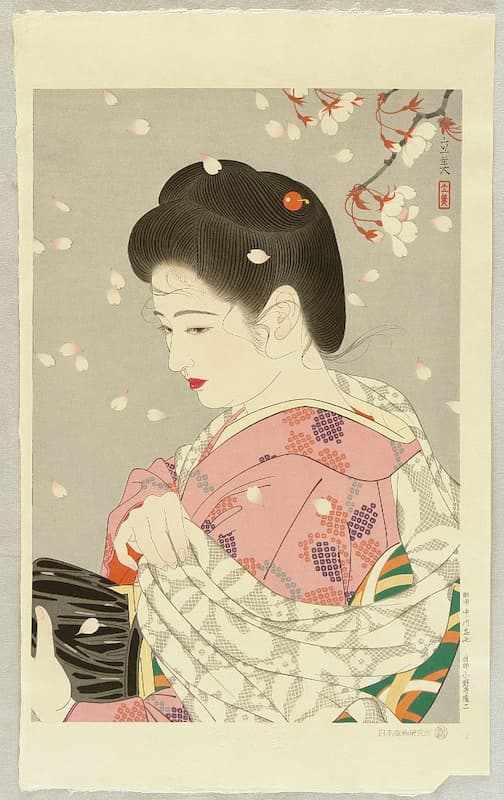
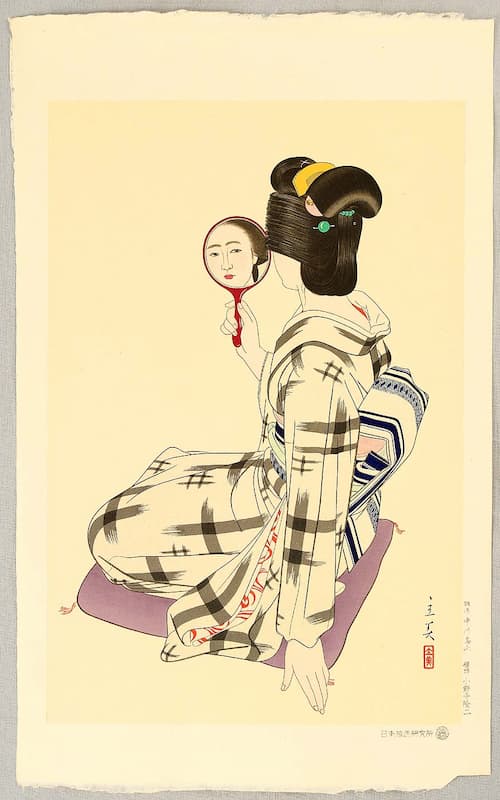
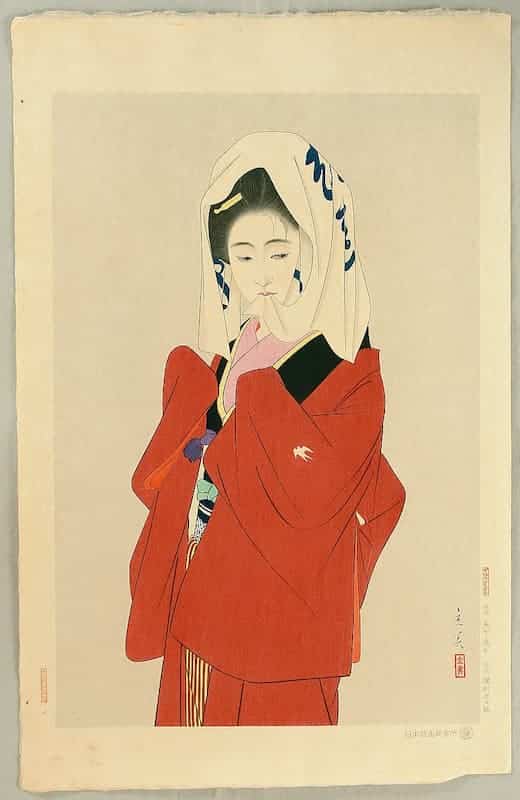
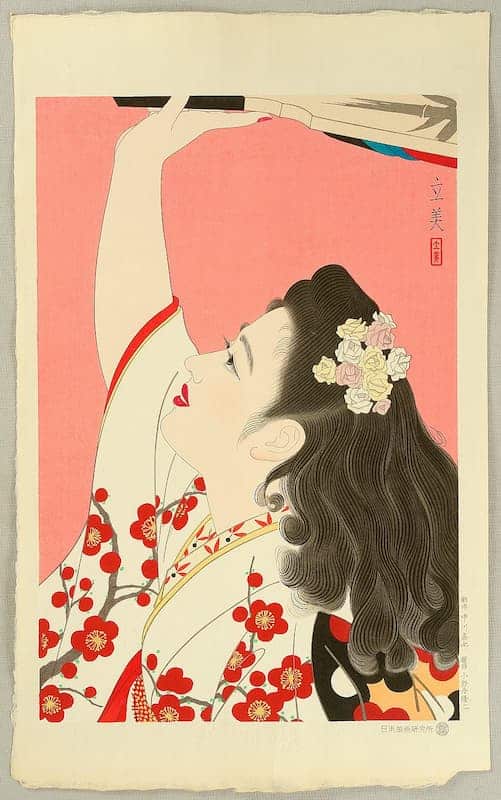
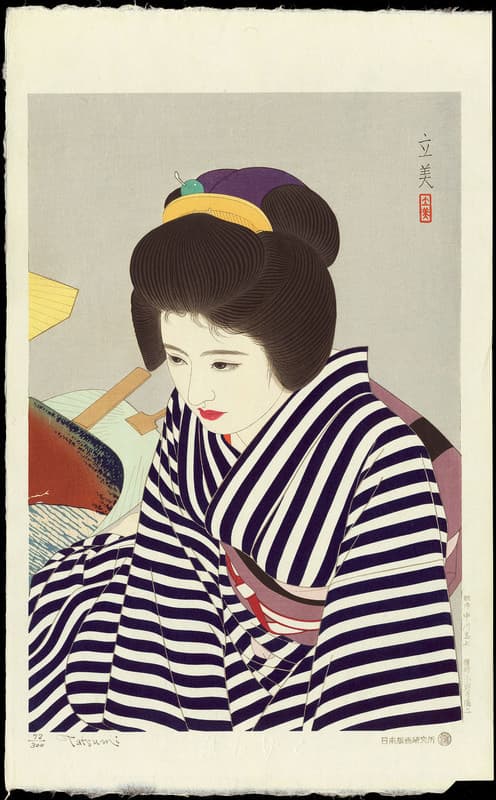
The series includes:
- “Cherry Blossom Storm”
- “Playing Battledore (Oibane)“
- “Late Summer”
- “Start of the Dance”
- “Hairstyle of a Married Woman”
This series was carved by Nakagawa Chushichi, printed by Onodera Ryuji, and published by Nihon hanga kenkusho (Japanese Institute for Woodblock Prints) as depicted by their seals (hanko). Each print is a technical marvel, showcasing Shimura’s mastery over the depiction of nuanced expressions and traditional attire set against simplistic backgrounds. “Late Summer” notably includes a clever allusion to Hokusai’s famous ukiyo-e print “Red Fuji,” depicted on the woman’s fan, blending historical artistry with contemporary themes.
Significance in Japanese Art
“Five Figures of Modern Beauties” is more than a collection of beautiful images. It serves as a cultural bridge, linking traditional Japanese art forms with modern expressions of beauty and emotion. Shimura’s series not only highlights the evolving roles of women but also preserves the quintessence of Japanese aesthetic principles in a changing world.
Each piece in the series tells a story of beauty, season, and emotion, making “Five Figures of Modern Beauties” a timeless testament to Tatsumi Shimura’s artistic legacy. Through this series, Shimura not only celebrated the beauty of Japanese women but also documented the cultural shifts of his time, leaving a lasting impact on the art of modern Japan.
Identifying Limited Editions
For collectors, distinguishing a limited edition Shimura print involves noting specific details: true limited editions will either display the edition number on the print or feature two thin red seals in the margins. The series comprises several editions, including one that notably lacks edition numbering but includes one or two thin red rectangular seals, indicating its status as an early, limited edition.
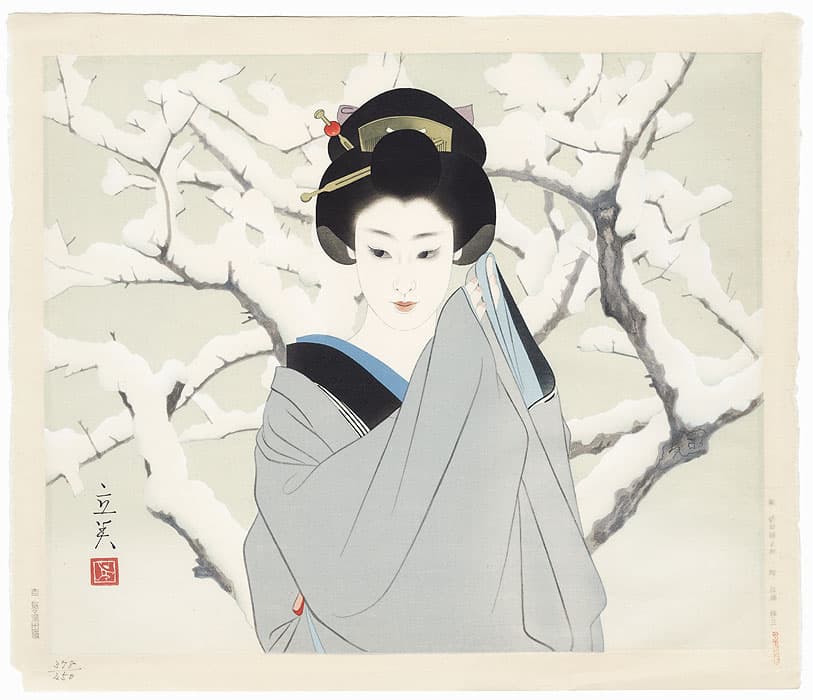
Legacy and Continuing Influence
Shimura’s contributions to art significantly influenced the preservation and evolution of Japanese traditional aesthetics in a modern context. His work serves as a cultural document reflecting the evolving roles and perceptions of women in mid-20th-century Japan. Following a solo exhibition on his sixtieth birthday in 1967, he dedicated his career entirely to Nihonga, or Japanese-style painting.
Today, Tatsumi Shimura’s artworks are celebrated for their historical significance and artistic merit. Museums and collectors around the world seek his prints, which continue to inspire new generations of artists and art enthusiasts. His ability to convey deep, reflective beauty remains unmatched, making his work a cornerstone in the study of modern Japanese art.
Conclusion
Tatsumi Shimura’s legacy as a master of modern Japanese beauty continues to inspire and captivate. His “Five Figures of Modern Beauties” series, in particular, offers a timeless glimpse into the blend of traditional and contemporary artistic expressions, establishing Shimura as a pivotal figure in the history of Japanese art. His work not only celebrates the aesthetic beauty of Japanese traditions but also documents the cultural shifts of his time.
Featured image above of Ohkawabata – Sumidagawa Riverside by Tatsumi Shimura
Read more:
- Kamisaka Sekka: A Maestro of Ukiyo-e’s Evolving Canvas
- Yoshitomo Nara: Blending Ukiyo-e and Pop Culture in Japanese Art
- Tatsuro Kiuchi: The Japanese Illustrator Who Loves Old Things
- Yayoi Kusama: A Polka-Dotted Revolution in Art

At The Art of Zen we carry a selection of our own hand-crafted original Japanese art prints in the ukiyo-e and Japandi style. Some of our best selling work is Mount Fuji wall art and Japandi wall art.
Add some zen to your space with brilliant original art from the Art of Zen shop.
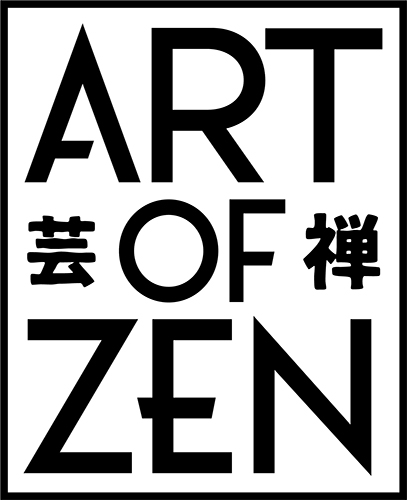
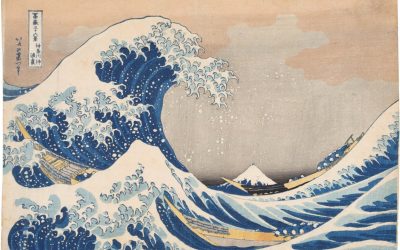
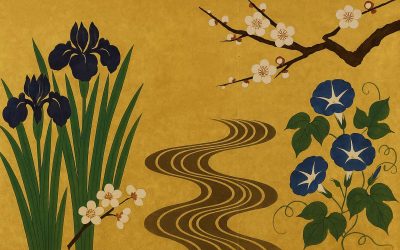

0 Comments